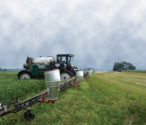Advertise Follow Us
Cover Crops
Bio Strip-Till: Best of Both Worlds
Using cover crops with strip-tillage helps growers improve the crop-row environment, build soil organic matter and protect fields from erosion.
Read More
What I've Learned from No-Tilling
Planning And Research Necessary For No-Till Success
Soaking up information from every possible source keeps Jim Hershey on a successful and productive no-till path.
Read More
Cereal Rye Helps No-Tiller Prevent Damaging Gullies
Cover crops can elevate no-till systems to the next level by protecting soil resources.
Read More








